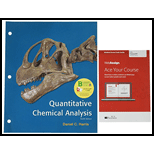
Concept explainers
(a)
Interpretation:
Using Table 4-1, the fraction of a Gaussian population that lies within the given interval has to be calculated.
Concept Introduction:
Gaussian curve:
The Gaussian curve is given by the formula:
Where,
e is the base of the natural logarithm
The deviations from mean value is expressed in multiples, z, of the standard deviation and which is given as follows:
The area under the whole curve from
To Calculate: Using Table 4-1, the fraction of a Gaussian population that lies within the given interval
(a)
Answer to Problem 4.2P
Using Table 4-1, the fraction of a Gaussian population that lies within the given interval is
Explanation of Solution
Given Interval:
Calculation of Gaussian Population:
The given interval
From the table 4-1, we know that the area from
Similarly, the area from
Therefore, the total area from
Hence, the fraction of a Gaussian population is
Using Table 4-1, the fraction of a Gaussian population that lies within the given interval is calculated as
(b)
Interpretation:
Using Table 4-1, the fraction of a Gaussian population that lies within the given interval has to be calculated.
Concept Introduction:
Gaussian curve:
The Gaussian curve is given by the formula:
Where,
e is the base of the natural logarithm
The deviations from mean value is expressed in multiples, z, of the standard deviation and which is given as follows:
The area under the whole curve from
To Calculate: Using Table 4-1, the fraction of a Gaussian population that lies within the given interval
(b)
Answer to Problem 4.2P
Using Table 4-1, the fraction of a Gaussian population that lies within the given interval is
Explanation of Solution
Given Interval:
Calculation of Gaussian Population:
The given interval
From the table 4-1, we know that the area from
Similarly, the area from
Therefore, the total area from
Hence, the fraction of a Gaussian population is
Using Table 4-1, the fraction of a Gaussian population that lies within the given interval is calculated as
(c)
Interpretation:
Using Table 4-1, the fraction of a Gaussian population that lies within the given interval has to be calculated.
Concept Introduction:
Gaussian curve:
The Gaussian curve is given by the formula:
Where,
e is the base of the natural logarithm
The deviations from mean value is expressed in multiples, z, of the standard deviation and which is given as follows:
The area under the whole curve from
To Calculate: Using Table 4-1, the fraction of a Gaussian population that lies within the given interval
(c)
Answer to Problem 4.2P
Using Table 4-1, the fraction of a Gaussian population that lies within the given interval is
Explanation of Solution
Given Interval:
Calculation of Gaussian Population:
The given interval
From the table 4-1, we know that the area from
Therefore, the total area from
Hence, the fraction of a Gaussian population is
Using Table 4-1, the fraction of a Gaussian population that lies within the given interval is calculated as
(d)
Interpretation:
Using Table 4-1, the fraction of a Gaussian population that lies within the given interval has to be calculated.
Concept Introduction:
Gaussian curve:
The Gaussian curve is given by the formula:
Where,
e is the base of the natural logarithm
The deviations from mean value is expressed in multiples, z, of the standard deviation and which is given as follows:
The area under the whole curve from
To Calculate: Using Table 4-1, the fraction of a Gaussian population that lies within the given interval
(d)
Answer to Problem 4.2P
Using Table 4-1, the fraction of a Gaussian population that lies within the given interval is
Explanation of Solution
Given Interval:
Calculation of Gaussian Population:
The given interval
From the table 4-1, we know that the area from
Therefore, the total area from
Hence, the fraction of a Gaussian population is
Using Table 4-1, the fraction of a Gaussian population that lies within the given interval is calculated as
(e)
Interpretation:
Using Table 4-1, the fraction of a Gaussian population that lies within the given interval has to be calculated.
Concept Introduction:
Gaussian curve:
The Gaussian curve is given by the formula:
Where,
e is the base of the natural logarithm
The deviations from mean value is expressed in multiples, z, of the standard deviation and which is given as follows:
The area under the whole curve from
To Calculate: Using Table 4-1, the fraction of a Gaussian population that lies within the given interval
(e)
Answer to Problem 4.2P
Using Table 4-1, the fraction of a Gaussian population that lies within the given interval is
Explanation of Solution
Given Interval:
Calculation of Gaussian Population:
The given interval
From the table 4-1, we know that the area from
The area from
Therefore, the total area from
Hence, the fraction of a Gaussian population is
Using Table 4-1, the fraction of a Gaussian population that lies within the given interval is calculated as
Want to see more full solutions like this?
Chapter 4 Solutions
QUANTIT.CHEM..(LL)-W/WEBASSIGN(6 MONTH)
 ChemistryChemistryISBN:9781305957404Author:Steven S. Zumdahl, Susan A. Zumdahl, Donald J. DeCostePublisher:Cengage Learning
ChemistryChemistryISBN:9781305957404Author:Steven S. Zumdahl, Susan A. Zumdahl, Donald J. DeCostePublisher:Cengage Learning ChemistryChemistryISBN:9781259911156Author:Raymond Chang Dr., Jason Overby ProfessorPublisher:McGraw-Hill Education
ChemistryChemistryISBN:9781259911156Author:Raymond Chang Dr., Jason Overby ProfessorPublisher:McGraw-Hill Education Principles of Instrumental AnalysisChemistryISBN:9781305577213Author:Douglas A. Skoog, F. James Holler, Stanley R. CrouchPublisher:Cengage Learning
Principles of Instrumental AnalysisChemistryISBN:9781305577213Author:Douglas A. Skoog, F. James Holler, Stanley R. CrouchPublisher:Cengage Learning Organic ChemistryChemistryISBN:9780078021558Author:Janice Gorzynski Smith Dr.Publisher:McGraw-Hill Education
Organic ChemistryChemistryISBN:9780078021558Author:Janice Gorzynski Smith Dr.Publisher:McGraw-Hill Education Chemistry: Principles and ReactionsChemistryISBN:9781305079373Author:William L. Masterton, Cecile N. HurleyPublisher:Cengage Learning
Chemistry: Principles and ReactionsChemistryISBN:9781305079373Author:William L. Masterton, Cecile N. HurleyPublisher:Cengage Learning Elementary Principles of Chemical Processes, Bind...ChemistryISBN:9781118431221Author:Richard M. Felder, Ronald W. Rousseau, Lisa G. BullardPublisher:WILEY
Elementary Principles of Chemical Processes, Bind...ChemistryISBN:9781118431221Author:Richard M. Felder, Ronald W. Rousseau, Lisa G. BullardPublisher:WILEY





